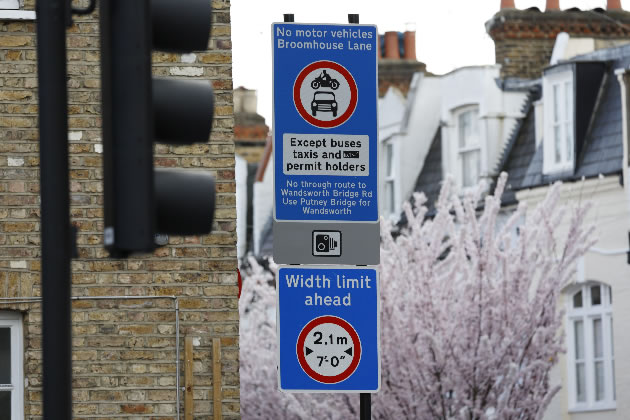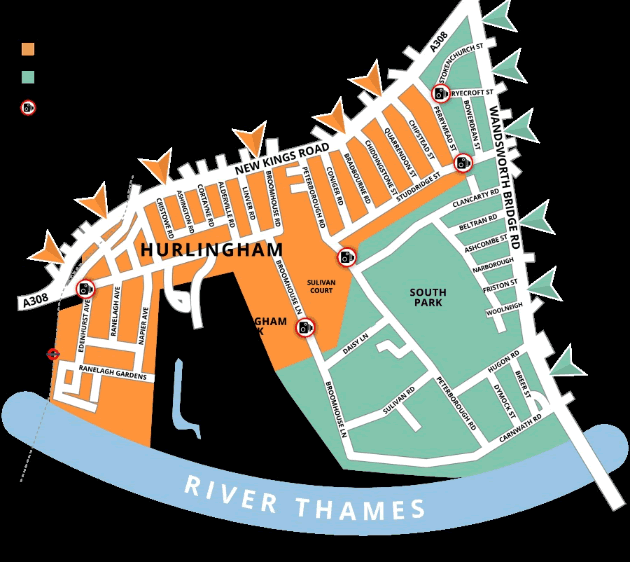South Fulham Clean Air Scheme to Be Made Permanent
Trial expansion of initial restrictions deemed a success by council

The Clean Air Neighbourhood trial west of Wandsworth Bridge was introduced in December 2022. Picture: Facundo
February 28, 2024
The extension to the South Fulham clean air scheme is recommended to be made permanent, as the council says data shows it has removed an average of 7,000 vehicles from its roads every day. Hammersmith and Fulham Council said the Clean Air Neighbourhood (CAN) trial in South Fulham has also led to cuts to carbon dioxide (CO2) and nitrogen oxide (NOx).
However, a campaign group opposing the CAN has however hit back at the proposed decision, accusing the council of using “selective data and partial facts to justify shifting traffic and pollution from affluent streets to already busy, more populous streets”.
The trial, which was implemented in December 2022 and covers the area west of Wandsworth Bridge, is part of efforts to make South Fulham “an even nicer place to live, work and shop with the ultimate goal of delivering cleaner air”, the council said. It was rolled out on the back of a similar scheme trialled east of the bridge, made permanent in December 2021, which the council says reduced the number of vehicles on the restricted roads by 8,000 a day. Opponents say that much of this traffic was simply displaced to non-restricted roads leading to more congestion and pollution in the wider area.
Similar in principle to low-traffic neighbourhoods (LTNs), the CANs involve the deployment of cameras to fine out-of-borough drivers cutting through local streets. They also feature a range of measures to improve climate resilience and biodiversity, including better walking and cycling infrastructure and sustainable drainage schemes.
Critics, such as the Traffic Camera Consulting Group, have previously raised concerns about the trial scheme’s hit on local businesses and perceived displacement of vehicles to other roads. Lauren Clark, who works with her partner, the owner of Randall’s Butchers on Wandsworth Bridge Road, previously told the Local Democracy Reporting Service (LDRS) the business has lost about 40% of its trade due to the CAN, with customers avoiding the area.

A map showing the South Fulham (West) CAN trial area. Picture: Hammersmith and Fulham Council
In a report published ahead of next Monday’s Cabinet meeting (4 March), in which it is recommended the CAN be made permanent, data compiled for Hammersmith and Fulham Council however indicates overall traffic was down when comparing volumes in several months both before and during the trial. The average daily traffic for Broomhouse Lane in March 2022, for example, was 7,869 vehicles. This dropped to 3,352 in March 2023, a reduction of 57.4%. Not all locations saw reductions in each instance, with Wandsworth Bridge Road North recording an increase of 16.4% when comparing June 2022 with June 2023. Fewer vehicles may also have resulted in improved air quality, with the data reporting an average of 0.65 tonnes of NOx and 0.9 tonnes of CO2 less daily.
Certain groups, such as carers and Black Cabs, as well as residents, are exempt from the cameras. Businesses can also issue exemptions to customers, in a bid to mitigate the impacts on their trade. According to the report, the number of such exemptions rose by 236% between March 2023 and November the same year, up from 1,696 to 5,695.
A consultation run earlier this year by Opinium, commissioned by the council, found respondents were generally in-favour of schemes which cut out-of-borough traffic using streets as cut-throughs (52%). This was significantly more popular among those living within the trial area (65%) than residents from the rest of the borough (45%), the latter of which were more likely to either be strongly opposed or opposed (46%). For businesses, the majority both inside (59%) and outside (57%) the zone were more likely to be opposed.
Concerns about safety were among those raised by residents, with recent coverage of Uber drivers refusing to drop women off at their homes if they live within the CAN. The council’s report notes the authority has worked with the taxi firm to resolve such issues, with tickets able to be cancelled if the driver can prove they picked up or dropped off a resident in the area.
Donald Grant, Chair of the Traffic Camera Consulting Group, accused the council of ignoring ‘thousands’ of residents with concerns, saying, “Officers imply that a poll shows residents generally support the LTN, but the survey didn’t ask that question, or explain the downsides and all those it impacts,” he said. “Again, they don’t acknowledge the division it has wedged in the community or the obliteration of buses and minicabs, and are still in denial over the damage to local shops and the safety concerns of women.
“They have chosen to engage with a minority of residents who stand to benefit from these divisive schemes whilst ignoring the thousands with valid concerns. The statistics presented don’t prove an overall benefit to the community, and don’t even mention the £10m a year collected in fines from our friends, families and neighbours.
“Councillors on LBHF’s Cabinet are fully aware of the damage they are causing, but have been whipped into imposing the LTN by their Leadership who see it as a political badge of honour. It’s time for Mark Harper, Transport Secretary, to step in and deny access to the DVLA database, or confiscate the fines revenue as happens in Scotland and Wales.”
Conservative Cllr Jose Afonso, who sits on the council’s Climate Change and Policy and Accountability Committee, said: “Despite worrying concerns around women’s safety, the negative effects on our small independent businesses and a poll that did not ask residents about the specific scheme in trial, Labour-run LBHF are proceeding to make the scheme permanent.
Lou Savage, a resident living within the CAN and part of the Clean SW6 campaign group, however praised the impact of the scheme on the area. “The implementation of the Clean Air Neighbourhood Scheme has profoundly improved the quality of lives for residents and the local community,” she told the LDRS. “Most roads within the scheme are narrow residential streets with car parking on both sides that sadly over the years had turned into unsafe ‘rat-runs’. The benefits of CAN are not just confined to a decrease in noise pollution, the reduction in the number of cars and their noxious exhaust fumes is a step towards the environmental transformation needed for everyone’s health and wellbeing.
“The scheme has served as a catalyst for our neighbourhood to adopt a more community-centric ethos, encouraging us to spend more time walking and cycling around local streets that are now cleaner and quieter.”
A Hammersmith & Fulham Council spokesperson said, “The trial was developed by residents. It set out to end a decades-old congestion and pollution problem in the streets around Wandsworth Bridge Road that had been exacerbated by the increased use of sat-nav equipment by motorists. The shared ambition is to make South Fulham an even nicer place to live, work and shop with the ultimate goal of delivering cleaner air and transforming Wandsworth Bridge Road into a destination high street.”
Ben Lynch - Local Democracy Reporter